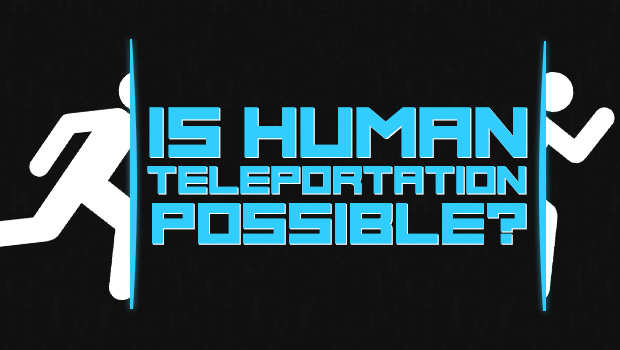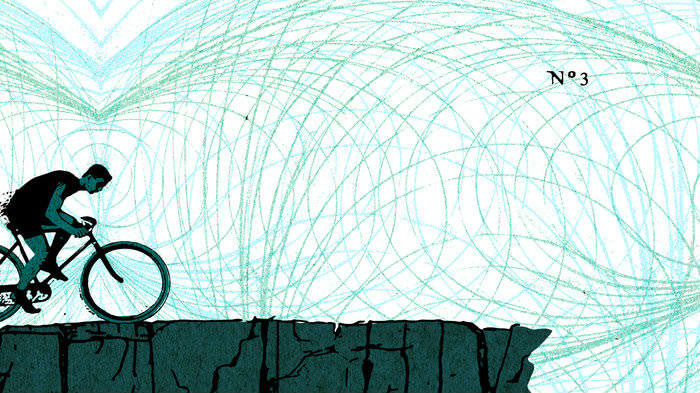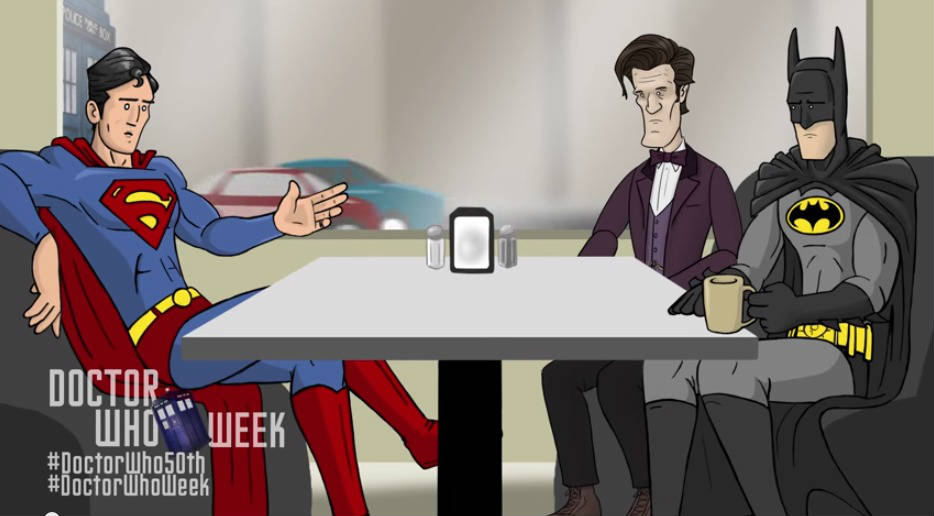Is Teleportation Possible?

The first of a two part series, we look at what needs to happen to make teleportation a reality.
In Christopher Nolan’s The Prestige, Wolverine and Batman are dueling magicians, trying to one up the other’s tricks. Wolverine gets the upper hand after buying a teleportation device from Nikola Tesla.
Mad scientist Jeff Goldblum, when not reverse engineering alien code or determining the status of earth girls, teleported from pod to pod with only one “minor” side effect.
Captains Kirk and Picard teleported from ship to alien planet too many times to count.
Marvel’s Nightcrawler teleports at will, leaving behind a purple cloud and large block lettering.
Those are just a few examples of teleportation in science fiction. That’s where teleportation has been, but we’re living in an interesting era.
Peruse news headlines from earlier this year. Two different companies invented a working hoverboard (Lexus & Hendo Hoverboard).
DARPA, who I’ve talked about before, wants to put the Internet in your brain and use microbes to terraform Mars.
Technology is advancing at such a rate, some pieces of science fiction are no longer fiction, just science.
Things like the hoverboard won’t revolutionize anything if it’s ever made for the masses. Teleportation, on the other hand, would reshape everything from the world economy to our day-to-day lives.
But will teleportation ever be possible?
Wikipedia defines teleportation as going from A to B without traveling the distance between the two points. The person is essentially dematerialized (zapped into nothing), then rematerialized (put back together) at point B.
That’s the way it’s done in science fiction. Star Trek does it that way. The Fly did it that way. So that’s what I’m going to talk about. (I think Nightcrawler cheats and uses a wormhole — lazy bastard.)
One day, teleportation might be as common as Starbucks. Until then, there are massive hurdles scientists have to clear before teleportation becomes a reality.
The body poses a multitude of problems that need to be figured out by the scientific types before we can *BAMPF* our way around the world.
(Side note: Quantum teleportation isn’t the same as the teleportation we’re talking about. It shares a name, but that’s all. Quantum teleportation is a form of communication among formerly entangled particles. It transmits information, not matter. Which, my friend, you and I are made of in spades. Quantum entanglement makes the news any time there’s a major discovery. Albert Einstein called it “spooky action at a distance” because it violated the rules of General Relativity. It’s confusing as shit, but cool as hell. I’d recommend reading up on it. But it’s not the same, despite headlines claiming the contrary. )
Energy and Breaking The Forces of Nature
Say you’re on the Starship Enterprise and Scotty is prepping to beam you down to a planet known for sandy beaches, attractive aliens, and cocktails strong enough to get a blue whale drunk. It’s been a long week, and as a nameless redshirt, you’ve survived through a few boarding parties.
Time to relax.
The machine’s warming up and, poof, you’ve been dematerialized. Every atom in your body has been destroyed.
And here’s where we meet the first problem with teleportation. The energy requirement to dematerialize a human body is staggering.
Think about how the human body is constructed. It’s a combination of various systems. Those systems are made of organs, which are made of specialized tissue, which is a collection of cells.
The rabbit hole goes deeper as cells contain smaller items called organelles. Those organelles, like the nucleus and mitochondria, are the product of various molecules. Molecules being the combination of two or more atoms.
If you want to put a number to it, from what I’ve read, 7 octillion atoms (7 followed by 27 zeros) seems to be the consensus for the human body. I believe the scientific term for an amount that large is a “shit ton.”
Even the atoms are comprised of smaller parts — protons, neutrons and electrons. So our bodies are nothing more than the expression of three particles, arranged in different combinations. You, me, your asshole neighbor, everybody.
Now that we have the body narrowed down to the basics, we need to separate them. We need to split the atoms into basic particles.
That’s not going to be easy.
Think of neutrons as the clingy boyfriend or girlfriend you couldn’t get away from. No matter what you said or did, they were always around. But unlike that person, neutrons will never take the hint. They’ll cling to the protons until something strong prys ‘em away.
And by strong, I mean strong.
It’s called the strong force which is a boring name, but slightly entertaining if you say it in Yoda’s voice. Anyway, the strong force is strong. It keeps the protons and neutrons packed tight in the nucleus.
See, there are four types of forces at work in the universe: gravity, electromagnetism, the weak force, and the strong force. We’re familiar with gravity. It’s what keeps us on the planet instead of being flung into space at 1,000 miles an hour.
Electromagnetism is stronger than gravity. If you’d like proof, look at the magnets on your refrigerator. Are they sliding down to the floor?
No. No, they are not.
The bond between the magnet and the metal in the refrigerator door is stronger than gravity’s pull. Even links between a weak electromagnet and a small piece of metal, like a paper clip, is strong enough to negate Earth’s gravity.
But the strong force blows electromagnetism and gravity out of the water by a country mile. (Which is longer than a city mile.) The strong force is about 137 times stronger than electromagnetism.
The strong force is 6*10^39 times stronger than gravity. Thats a six followed by 39 zeros or 6,000,000,000,000,000,000,000,000,000,000,000,000,000.
With a force that strong holding protons and neutrons together, I’m sure you’re wondering how in the hell we’re able to move around. There’s the catch to the strong force. It only works at insanely small distances.
Imagine you’re holding a strand hair. Now imagine you cut the hair lengthwise into 100 equal pieces. Each slice is 1/100th of the original size.
The new strands, the ones you just cut, are insanely small. But we’re not done shrinking. Try to imagine a distance that’s one billion times smaller than the diameter of one of those strands. That’s the distance at which the strong force works.
It’s an extremely small distance to think about. I’ve been looking at this post for weeks and STILL can’t fathom such a small area.
But now we know what keeps the protons and neutrons together in an atom’s nucleus. Now that we’ve identified it, we need to break it.
For teleportation to work, we have to break these particles apart.
Think back to the strongest pair of magnets you’ve ever pulled apart. It took energy to separate them. Breaking the strong force is no different. The farther the particles are from each other, the weaker the strong force becomes.
But we’re talking about a force that’s 6*10^39 stronger than gravity. That’s where the massive energy requirement comes in. Figuring that out will require some math.
Dematerialization And The Energy Problem
Luckily, neither you or I will be doing any calculations to figure this out. Lawrence M. Krauss already has.
Krauss, a theoretical physicist and cosmologist, wrote The Physics of Star Trek. In it, he touches on the show’s teleportation.
According to his book, to break atoms apart for dematerialization, the teleportation machine needs to generate temperatures around a million times hotter than the sun.
FYI, the sun’s surface runs around 10,000 degrees Fahrenheit.
Designing a machine that could create and control that much energy without any collateral damage is a challenge in itself. Call it a hunch, but I don’t know of any material on this planet that withstands such extreme temperatures.
But there’s another problem to deal with.
While we need that energy to break everything apart for teleportation, there’s a nasty side effect: the atoms lose their mass. That’s a huge problem.
The Higgs-Boson particle, also known as “The God Particle,” is what gives everything (you, me, this computer) mass. It’s existence has been theorized for decades. Scientists found it recently, using the large Hadron Collider (LHC). It’s a fancy name for a large machine designed to smash particles together at extremely high speeds.
Since scientists just found its existence by taking it out of a particle, it’s going to be some time before they figure out how to put it back in.
We’ve barely stepped foot on the transportation deck and we’ve already hit a major hurdle. But, for the sake of conversation, let’s keep going.
As Krauss points out in his book, breaking atoms apart requires a lot of energy. So breaking apart a single atom would generate temperatures hotter than the Devil wearing winter gear in the middle of August in New Orleans.
But that’s just a handful of atoms. What about something human sized? Krauss estimates the amount of energy needed to dematerialize a person would be the equivalent to a one megaton hydrogen bomb.
(Note: A nuclear bomb’s blast power is measured in kilotons or megatons. A kiloton, or KT, is the equivalent to the blast power of 1,000 tons of TNT. A megaton, or MT, has the blasting power of a million tons of TNT.)
Let’s put some context behind that claim shall we?
The United States dropped Little Boy and Fat Man on Japan to end the last World War. Little Boy was a 15 kiloton nuclear bomb while Fat Man came in at 21 kilotons.
We’ve seen the horrific effects of a nuclear bomb. When Little Boy exploded in Hiroshima, the blast was so intense, it burned shadows into nearby structures.
If Krauss is correct, then dematerializing a human would need the energy of four Fat Man bombs or six Little Boys.
So it’s not just you that get’s dematerialized, it’s almost an entire city. Where you stood, there’s now a crater 200 feet deep and 1,000 feet in diameter. Almost every man-made structure is gone, save for building foundations made from reinforced, poured concrete. Anyone in a 1.7-mile radius is toast.
But that’s not all. Within a 2.7 mile radius, a pressure wave would blow out the walls of buildings, leaving some support structures intact. 50% of the people living in this region are goners and 40% are severely injured.
And the pressure wave keeps going.
It’s strong enough to destroy or heavily damage any house or apartment. The windows and the people on that floor are laying on the streets below. That’s within a 4.7-mile radius from the blast.
Things calm down within a 7.4-mile radius. Commercial buildings sustain minimal damage while homeowners get to talk with their insurance company about new windows, roof, and walls. At this point, most people are fine but some are injured from flying rubble. Others might have burns from the thermal radiation.
If you hear of any scientist or engineer trying to build a teleportation device, pack up all your shit and get the hell away from that crazy bastard. Far away.
To recap, we have three important problems with dematerialization that have to be solved.
- To break atoms apart, you need ungodly hot temperatures. Approximately a million times hotter than the sun.
- At those temperatures, atoms lose their mass and that’s something we need to keep.
- But dematerialization needs the energy of a nuclear bomb strong enough to wipe a city from existence.
We haven’t touched on the other issues and making teleportation possible is already daunting. That doesn’t mean it’s impossible. Finding a solution will just take longer than sci-fi fans would like.
The Data Transfer Problem
Let’s say a scientist comes along who is the next Tesla, Einstein and Mendel. Said man or woman solves all the problems we’ve covered so far.
They can break the human body down without blasting a city out of existence and the atoms keep their mass.
Breaking your body down was just one part of the puzzle. Now there has to be a way to get “you” to your destination. And we have to be quick about it.
Time is not on our side. Neutrons are not stable particles outside of an atom. It has 14 minutes to return to a nucleus. If it doesn’t make it back, it will devolve into a proton and electron.
To transfer all the information that is us, we need break-neck speed.
To give you an idea of how much information is in our cells, let’s look to Harvard.
In 2014, Harvard scientists claimed to use 1 gram of DNA for data storage. That gram, they said, held 700 terabytes of information.
They used each base pair as a binary reading. They were either 1 or 0, on or off. The DNA was then decoded, where the information was deciphered and the output was a 700 terabyte file.
So let’s take that idea and apply it to one strand of DNA.
One string of human DNA has 3 billion base pairs. Following Harvard’s model, that’s 3,000,000,000 bits of information. Bits being the smallest size of digital storage. Long story short, 3 billion bits is the same as 300 gigabits.
Now that we have the DNA converted into data, we have to move it. Remember, we have to teleport to point B faster than 14 minutes. We need the fastest connection for data transfer available.
Cable internet is anywhere between 35-50 megabits a second (Mbps) on a good day, but that’s too slow. Google offers a 1 gigabit (Gbps) fiber download speed. Comcast is building a 2 Gbps connection.
But we need faster speeds. We’re teleporting a lot of information here. One or two gigabits won’t hack it.
The fastest speed comes from U.S. Internet, a company in Minnesota. They claim and offer a download speed of 10 Gbps for a modest $399 a month. (ye gawds)
At that speed, teleporting an entire strand of DNA only takes 30 seconds. In 14 minutes, you’d have 7 strands of DNA transferred.
Of trillions and trillions of cells in your body, the fastest speed we have would only move seven strands of DNA.
So using a fiber network isn’t in the cards. It’s too slow for our needs. The other reason is fiber optics transmit signals, not matter.
There is one network that could move our dematerialized particles in a timely manner: The Large Hadron Collider. The LHC has the horsepower to push particles down a tube at near light speed.
But that comes with a huge price tag. The one firing particles all over the place in Europe cost about $6.4 billion to build. It’s operational budget floats around the $1 billion mark each year.
The LHC is just a loop. For teleportation, we’d need an elaborate infrastructure. Not everyone lives in the same city or state or wants to visit your grandma in Fort Lauderdale, FL.
No business or government would touch that project with a 10-foot cattle prod.
But what if, instead of teleporting every single particle, the machines send or receive a single strand of DNA?
It doesn’t solve the energy requirements from earlier, but it could be a workaround for the data transfer problem.
Since we’re not teleporting the actual particles, we won’t have the 14-minute time limit to worry about.
We also wouldn’t have to deal with the huge file size that would be the human body. We can cheat and use a template as 99% of everyone’s DNA is identical. The remaining 1% is responsible for the differences between you and every other person on the globe.
DNA, after all, is just the instructions on how your body is built. Who’s to say we couldn’t take those instructions and tell a 3D bioprinter to do the same thing?
Check back next week for part 2, where we’ll talk about 3D bioprinting and the hard problem of consciousness.




